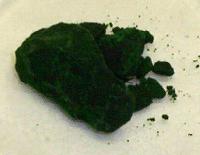
in the USA) inmultivitamin, multimineral products (Riihimaki & Luotamo, 2006).They are also marketed for weight loss purposes and athletic supplements. UsesĬhromium(III) chloride and chromium(III) sulfate have been used as dietary supplements (approved for themanufacture of foods for particular nutritional uses and in food supplements in the European Union), whereas the organic chromium(III) complexes chromium picolinate and nicotinate are not approved in the European Union but find widespread uses (e.g. 3THF.Ĭhromic chloride is a highly corrosive, Blue or greenish to black crystalline solid.For example, with tetrahydrofuran (THF) in the presence of zinc, it forms the violet crystals of the complex CrCl3 It forms adducts with many donor ligands. Reducing agents such as SnCl2 can “solubilize” CrCl3 in water. However, it readily dissolves in the presence of Cr2+ ion. When heated with hydrogen, it is reduced to chromium(II) chloride with the formation of hydrogen chloride:Ĭhromium(III) chloride has very low solubility in pure water. The tetrahedral tetrachloride is unstable, and occurs only in vapor phase. Heating with excess chlorine produces vapors of chromium(IV) chloride, CrCl4. Alternatively, the red-violet anhydrous chloride can be obtained by passing chlorine gas over a mixture of chromic oxide and carbon:Ĭhromium(III) chloride at elevated termperatures decomposes to chromium( II) chloride and chlorine: 6H2O with SOCl2 and subliming the product in a stream of chlorine at 600☌.6H2O The anhydrous chromium(III) chloride may be obtained by heating the hydrated salt CrCl3.UsesĬhromium(III) chloride is used for chromium plating as textile mordant in tanning as a waterproofing agent and as catalyst for polymerization of olefins.Ĭhromium(III) chloride hexahydrate may be prepared by treating chromium hydroxide with hydrochloric acid: /> Cr(OH)3 + 3HCl + 3H2O → CrCl3

The vapor-phase co-reductions with other metal halides by hydrogen results in finely divided intermetallics with applications as structural materials or compounds with useful thermoelectric, magnetic, and oxidation-resistance properties. It can also be used in the preparation of ionic liquid mixtures using choline chloride and water with improved ion mobility and conductivity. The color of hexahydrates range from light-green to violet all are hygroscopic density 1.76 g/cm3 soluble in water and ethanol insoluble in ether dilute aqueous solutions are violet in color.Ĭhromium(III) chloride can be used in the formation of a catalytic system for the conversion of glucose into 5-hydroxymethylfurfural (HMF). Reddish violet crystals hexagonal plates density 2.87g/cm3 melts at 1,152☌ decomposes at 1,300☌ slightly soluble in water.


 0 kommentar(er)
0 kommentar(er)
